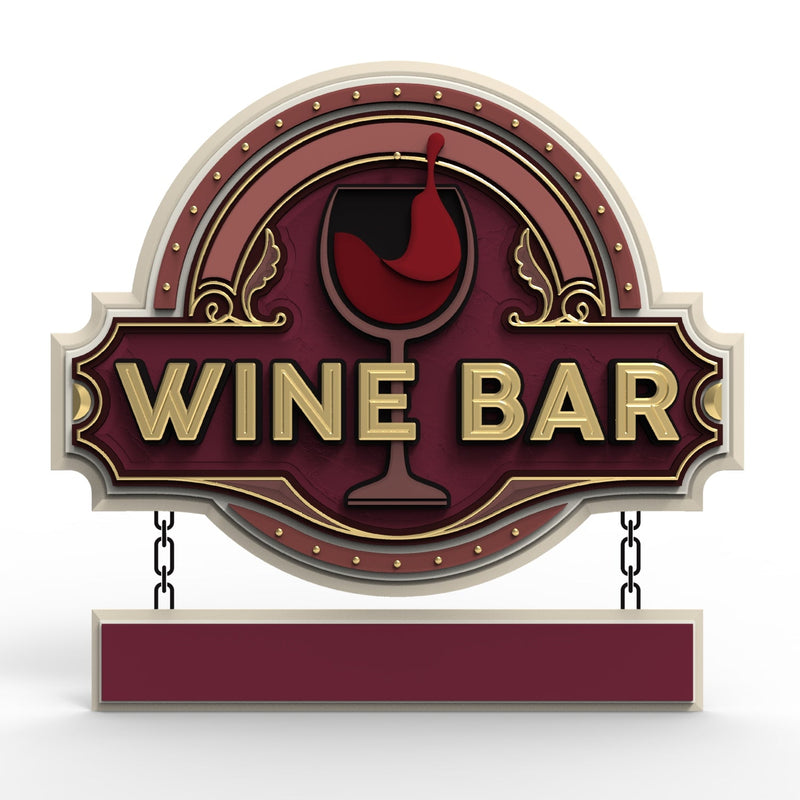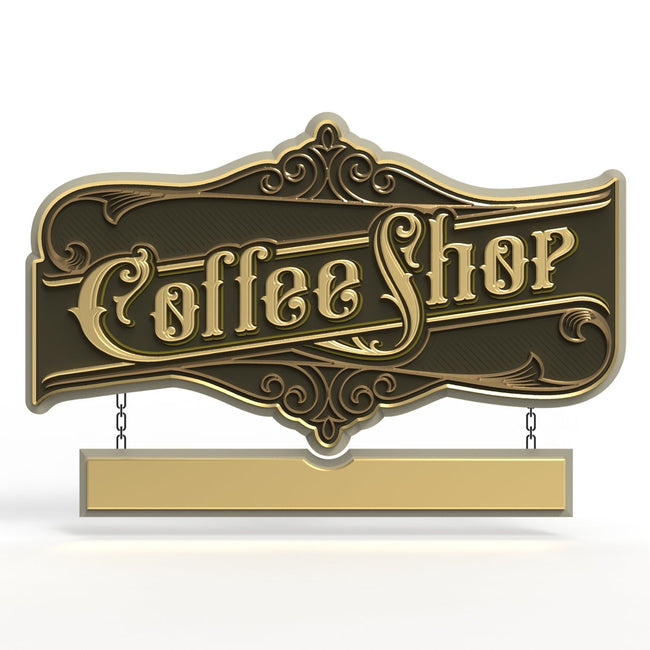Introduction
Carved dimensional signs are workhorses of place-making and branding. They add depth, texture, and permanence that flat prints can’t match, and they hold up well in demanding environments—from sun-baked main streets to high-traffic lobbies. When organizations shop for carved signage, the first big decision is whether to choose a template-based design or commission a fully custom piece.
Template-based carved signs offer pre-engineered design frameworks—proven shapes, border styles, typographic systems, and mounting details that can be adapted to your brand. They strike a smart balance between quality, speed, and cost control. But they aren’t always the right answer. In some cases, you’ll see more value from a custom concept that’s engineered around your architecture, your audience, and your brand story.
This guide walks you through how template systems work, where they shine, where they fall short, and how to make a confident decision for your storefront, campus, or wayfinding program.
When Template-Based Carved Signs Are the Best Choice (and When They Aren’t)
What “template-based” really means
A sign template is not a low-effort layout. It’s a standardized, build-tested system of shapes, edge profiles, layering methods, materials, and letter treatments that a fabricator can reproduce predictably. Within the system, you can swap brand colors, typefaces (within legibility rules), logos, and size ranges while retaining the underlying engineering: panel thickness, relief depth, hardware, and finishes optimized for durability and readability.
Typical elements provided by a template system:
-
Panel shapes and proportions (e.g., oval, shield, arched rectangle)
-
Edge treatments (chamfer, cove, ogee) and raised borders
-
Lettering style options (v-carved, prismatic, raised/applied, or recessed)
-
Relief backgrounds (smooth, sand-carved, woodgrain, stipple, linen)
-
Mounting methods (raceway, French cleat, post-and-panel, bracket/hanger)
-
Size bands with validated visibility distances
-
Finish schedules (primers, urethane topcoats, protective clear)
Common materials:
-
High-Density Urethane (HDU) for stability and weather resistance
-
Cedar or redwood for natural warmth (with appropriate sealing)
-
Aluminum or steel accents for brackets, frames, and posts
-
Acrylic or metal letters applied as raised elements
-
Gold leaf or metallic foils for premium highlights (on select templates)
The value of a template is the repeatable craft and the shorter path from idea to install—without gambling on untested geometry, mounting, or finishes.
Where templates excel
1) Multi-site rollouts and franchised brands
If you manage a chain, campus, or portfolio of properties, templates give you a controlled, scalable kit. You can lock a core style (panel shape, border, background texture) and vary only the location name or department. That keeps procurement simple, protects brand consistency, and makes maintenance straightforward.
2) Predictable budgets and tighter timelines
Because the engineering, machining paths, and finishing steps are standard, fabricators can quote more tightly and build faster. Your team gets accurate schedules, fewer surprises, and less back-and-forth in design development.
3) Compliance-heavy environments
Historic districts, HOAs, and corporate campuses often publish strict sign standards (materials, illumination, sizes, color limits). A template series that already fits known constraints helps you win approvals and avoid redesign cycles.
4) Cohesive wayfinding systems
Wayfinding works best when sign families share proportions, typography, and hierarchy. Templates make it easy to establish consistent information patterns—primary IDs, directional blades, parking identifiers, and regulatory plaques—so visitors can scan and understand quickly.
5) Small businesses seeking premium look without bespoke design fees
Boutique retailers, professional services, restaurants, and salons often want the dimension and presence of a carved sign but need certainty on cost. Templates deliver genuine craftsmanship, real carving depth, and attractive finishes at a friendlier price point than one-off custom.
Readability: why templates often outperform ad-hoc custom
Sign readability isn’t only about style; it’s physics and human factors:
-
Viewing distance vs. letter height: Templates often map letter heights to typical setback distances (e.g., 1 inch of letter height for every 25–30 feet of viewing distance as a baseline).
-
Stroke width and counterforms: Well-engineered templates avoid hyper-thin strokes and protect interior letter spaces that vanish at distance.
-
Contrast and glare control: Textured reliefs suppress reflections; raised borders frame the message against busy backgrounds.
-
Hierarchy rules: Primary name, secondary descriptor, and street number are weighted to be scannable in motion.
Because these parameters are pre-validated, a template can outperform a one-off custom that looks stylish on screen but struggles in real conditions.

When templates are not the best choice
Despite the strengths, there are scenarios where a custom carved sign is the right call:
-
Flagship locations and architectural integration
If your storefront is a landmark or your architecture is a brand statement, you may need a custom silhouette, layered sculpture, or specialty bracketry that templates don’t support. -
Complex logos or intricate brand marks
Highly detailed crests, script monograms with hairline strokes, or complex negative spaces may call for bespoke engineering, selective hand-carving, or mixed materials. -
Unusual sizes or extreme environments
Oversized spans, very high wind exposure, or atypical mounting surfaces (stone façades, curved walls) often require custom structure, reinforcement, or hardware. -
Special finishes and artisan techniques
Heavy gilding, patinated metals, deep bas-relief illustration, or compound curves typically go outside a template’s cost and schedule assumptions. -
Districts that demand exact replicas
Some historic approvals require replication of period details or nonstandard typography; that’s a custom project.
In these cases, a skilled fabricator will recommend a custom path—or a hybrid approach that starts with a template panel and adds custom architectural elements.
Practical decision framework
Use this checklist to choose confidently:
Audience & viewing conditions
-
Primary audience: driver, pedestrian, or interior visitor?
-
Typical viewing distance and speed?
-
Lighting: direct sun, shade, or artificial?
-
Competing visual noise: foliage, busy streetscape, reflective glazing?
Brand needs
-
Is consistency across locations critical?
-
Do you need an unmistakable flagship statement?
-
Are there elements of your logo that require special treatment?
Constraints & approvals
-
District/HOA rules on materials, sizes, illumination, or colors?
-
Accessibility or code requirements for certain messages?
Budget & schedule
-
Is speed to opening a priority?
-
Is there a programmatic need to repeat the sign at scale?
Lifecycle & maintenance
-
Will you rebrand or expand within 3–5 years?
If you’re checking boxes for multi-site consistency, approvals, and schedule, a template is often ideal. If you’re prioritizing singular brand expression and architectural storytelling, lean custom.
Common pitfalls (and how templates help avoid them)
-
Illegible type: Overly thin scripts or condensed fonts can fail at distance. Templates flag unsafe choices and suggest alternatives.
-
Low contrast: Dark text on mid-tone backgrounds disappears in shade. Templates pair tested contrast ratios.
-
Oversized logos that crowd text: Good systems protect margins and hierarchy.
-
Unverified mounting hardware: Template specs include proven brackets and load ratings.
-
Ignoring maintenance: A template often comes with maintenance notes and easy color codes for touch-ups.
FAQs (Frequently Asked Questions)
Q1: How is a template-based carved sign different from a custom sign?
A template-based sign uses a pre-engineered design system—established shapes, edge profiles, letter treatments, and mounting details—customized with your brand elements. A fully custom sign starts from a blank slate, which allows unique forms or specialty techniques but requires more design time, prototyping, and approvals.
Q2: Will a template sign look generic?
Not if it’s executed well. Color, typography, logo handling, texture, and small features (borders, medallions, gilded highlights) provide distinctive character. To most visitors, a well-chosen template reads as a tailored, high-quality sign because the craftsmanship and finishes carry the visual weight.
Q3: Are template signs as durable as custom?
They can be more durable because the materials and finishes are standardized and build-tested. With HDU, quality primers, and urethane topcoats, you get excellent weather resistance. The repeatable specs also ensure hardware and sealing steps aren’t reinvented each time.
Q4: How fast can I get a template-based sign compared to custom?
Timelines depend on workload and permitting, but templates typically shorten proofing and fabrication because machining paths and finish schedules are known. You avoid the extra concept rounds, prototyping, or engineering that a one-off custom often requires.
Q5: Can template signs meet local codes or historic guidelines?
Yes—many template families are designed to align with common district rules for materials, size caps, illumination restrictions, and color ranges. Your fabricator can provide drawings and materials sheets to support approvals.
Conclusion
Template-based carved signs are a practical, high-quality path to dimensional branding: they deliver predictability, speed, and cohesion across locations without sacrificing the premium look people expect from carved signage. They shine for multi-site rollouts, compliance-heavy districts, fast timelines, and unified wayfinding programs. They also help small businesses lock in craftsmanship and readability while staying in control of budget.
That said, there are clear cases for a custom build—flagship storefronts that demand architectural integration, intricate logos that need special handling, unusual sizes or mountings, or finishes that live in the realm of artisan work. In those moments, the extra design and engineering investment pays back in distinctiveness and long-term brand equity.
If you’re choosing between the two, start with the basics: audience, viewing distance, brand priorities, approvals, timeline, and maintenance plan. When a template checks those boxes—and your brand elements sit comfortably within its rules—you’ll get a sign that works hard every day, for years. When your vision pushes past the edges of a system, a custom route will serve you better. A seasoned fabricator can show you both paths and guide you to the right decision for your space, your budget, and your brand.
Getting high-quality 3D carved signs has never been this easy! We use only the highest quality material and paint finishes available for unmatched elegance and longevity. Check out Carved Signs and our outstanding sign collection. Just pick your style and customize it - we do the rest! Feel free to contact us online or call us at +1 (970)-455-8443.




